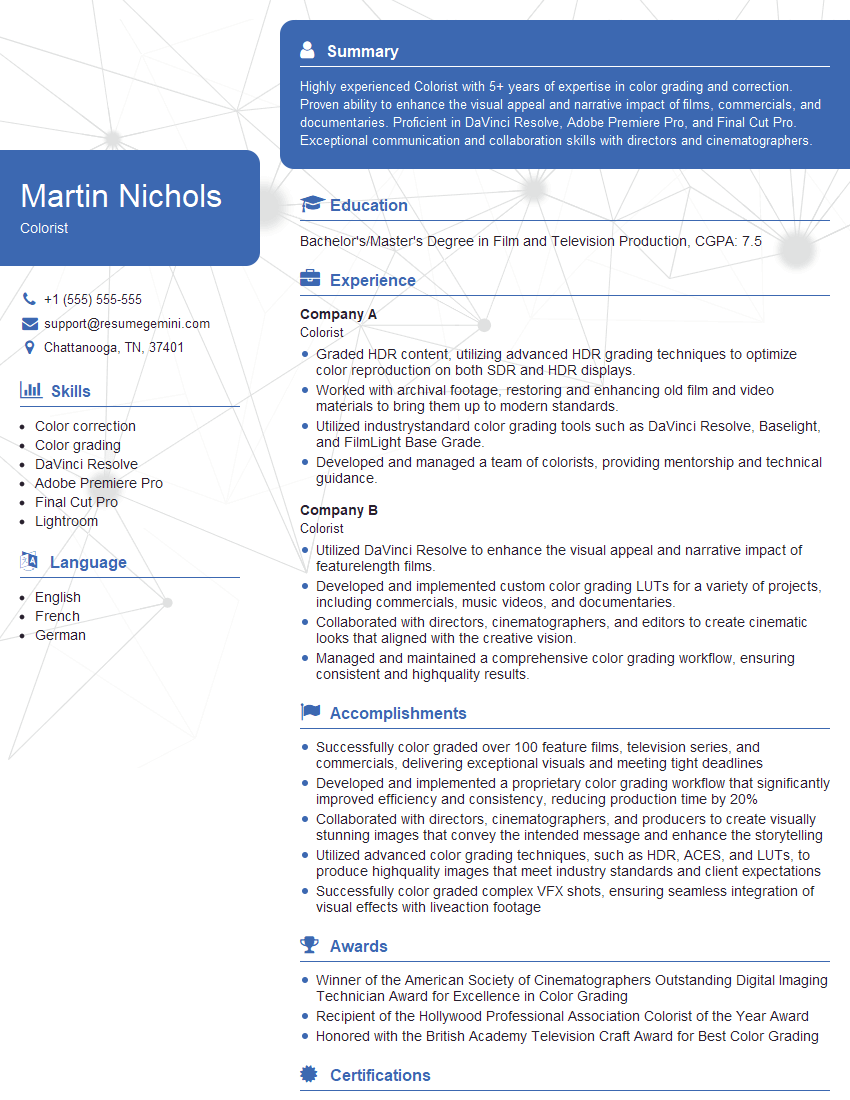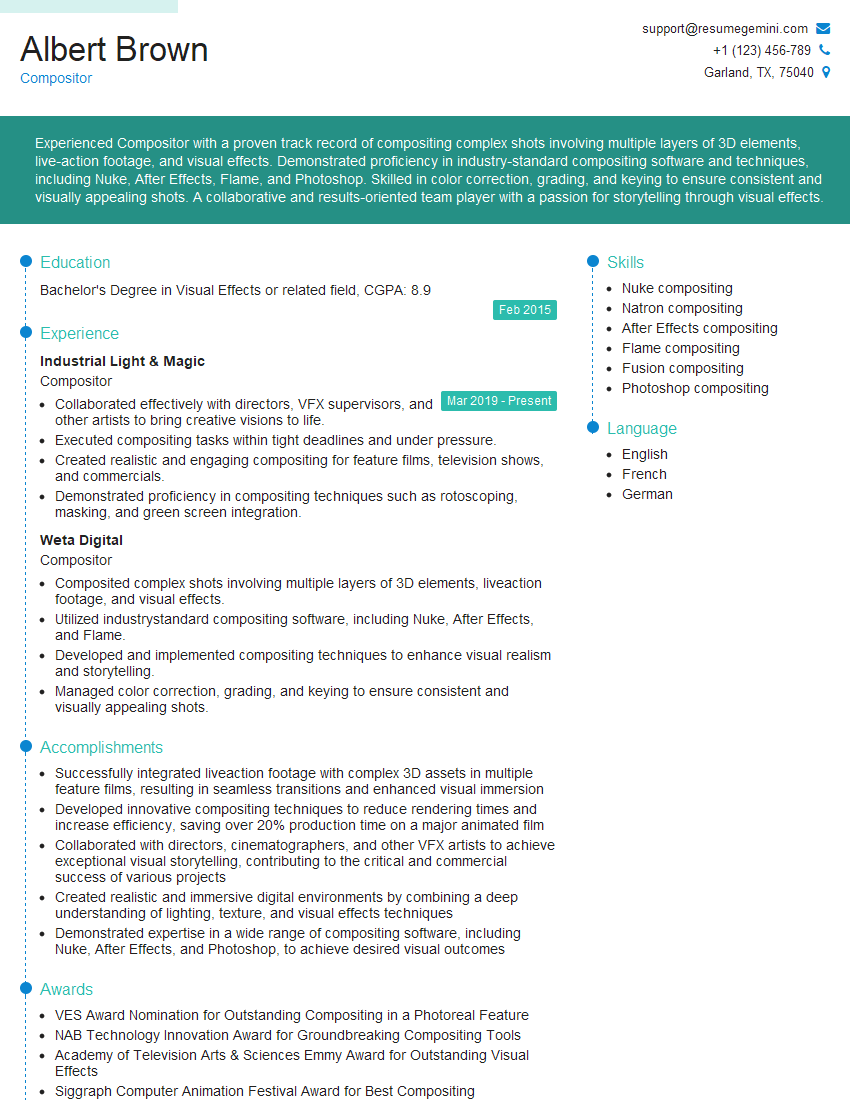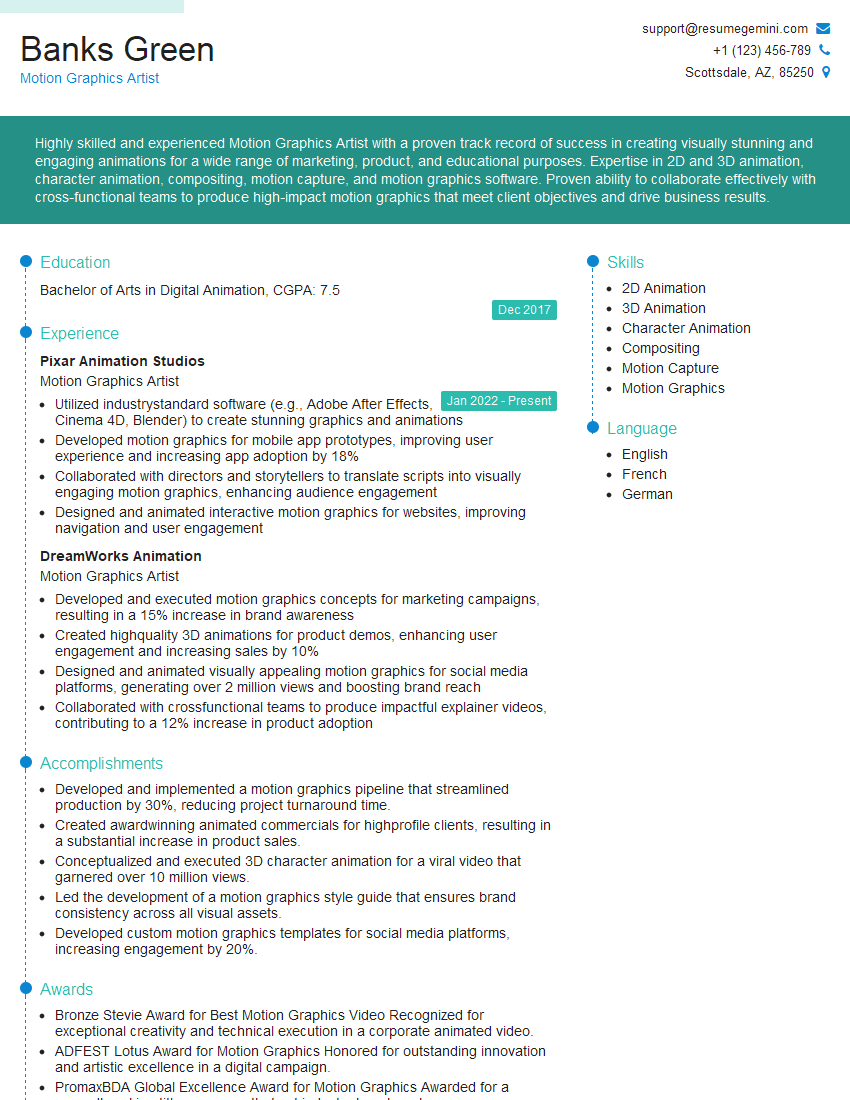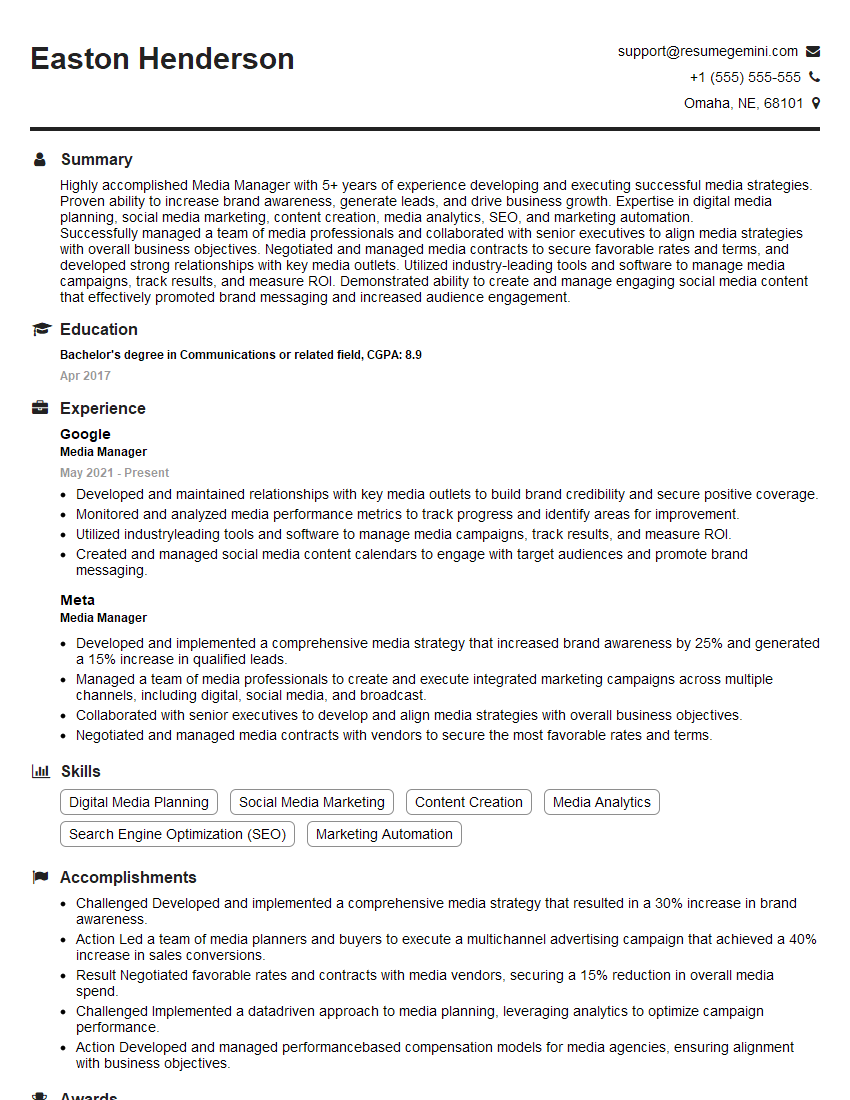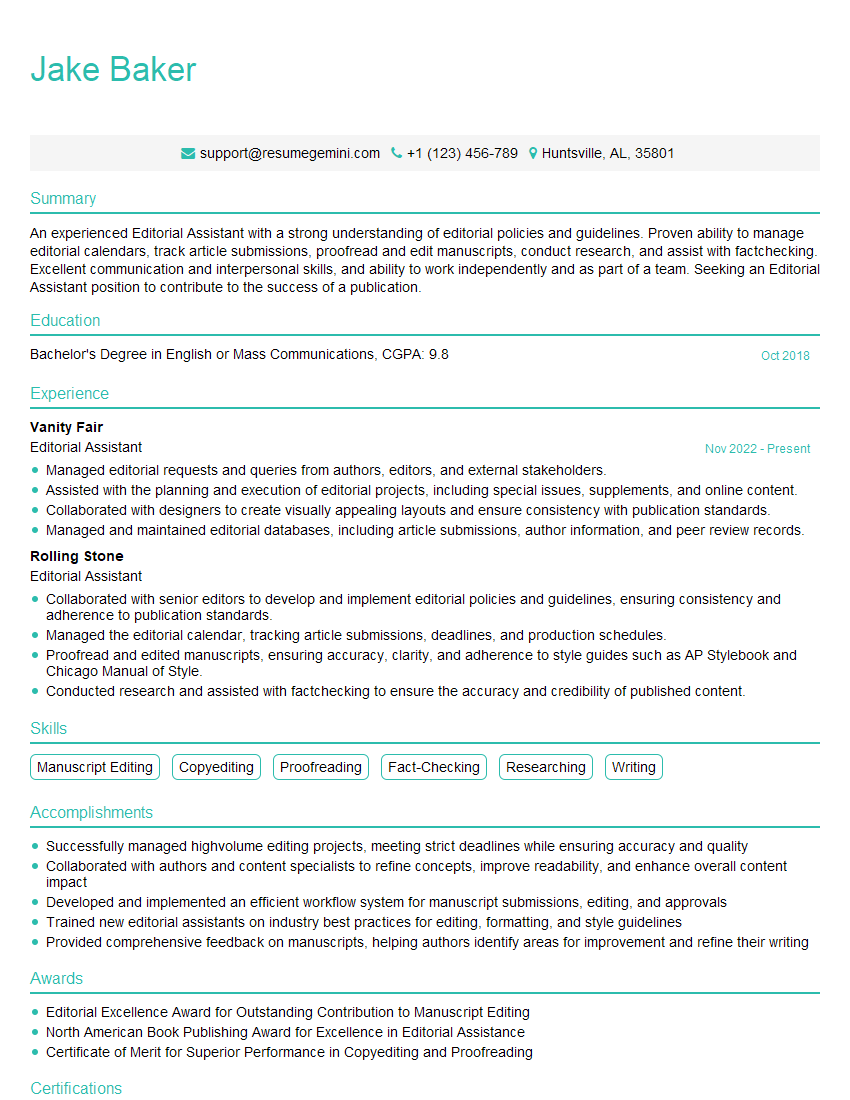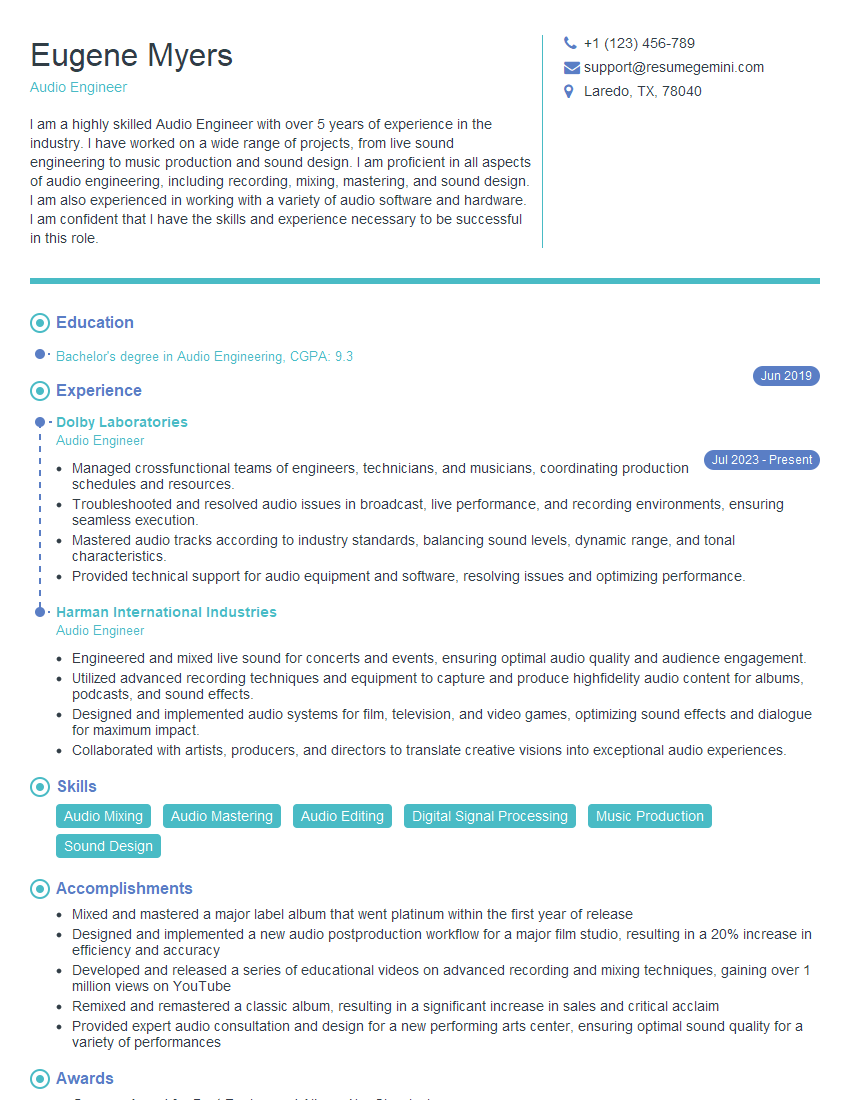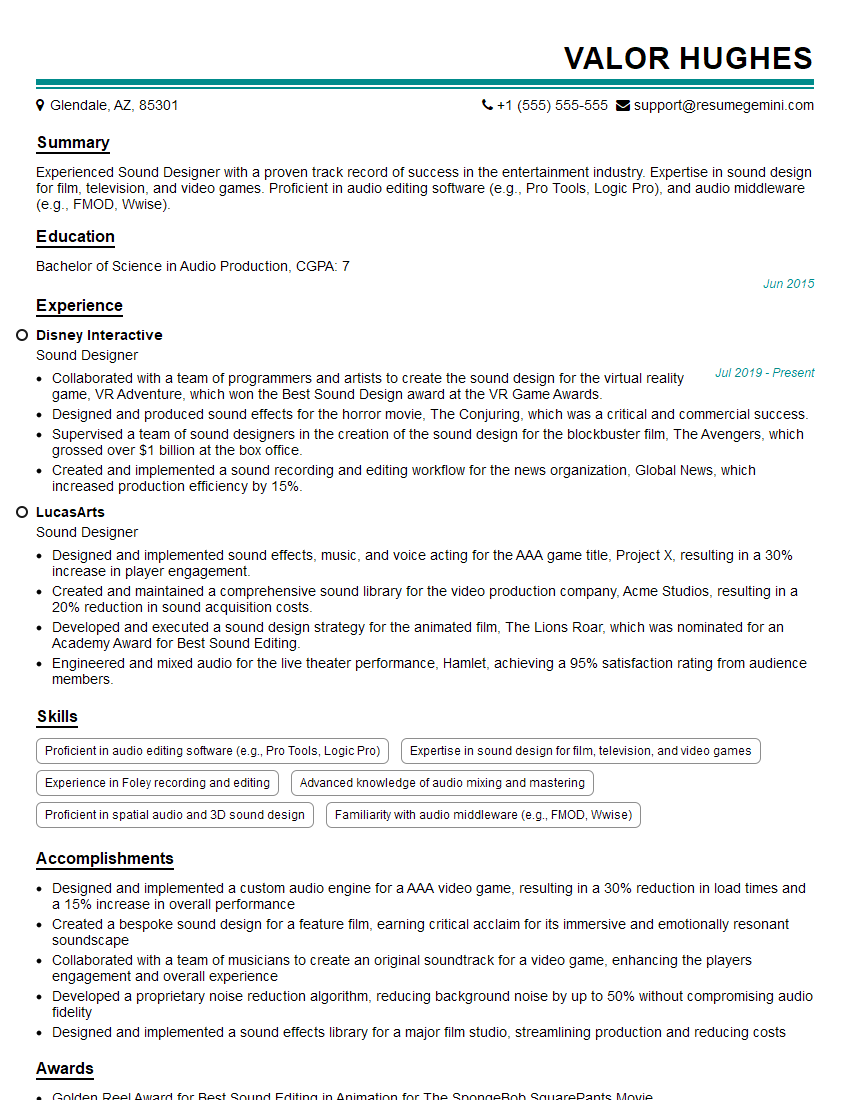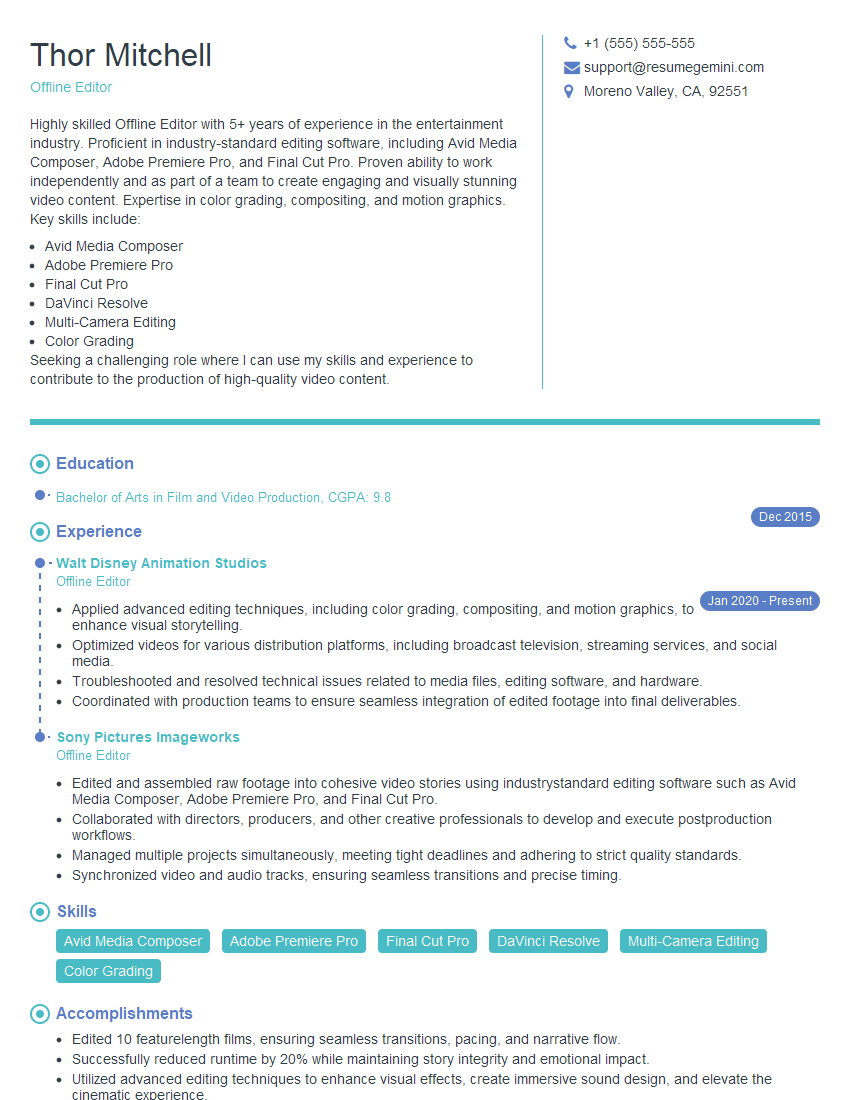The thought of an interview can be nerve-wracking, but the right preparation can make all the difference. Explore this comprehensive guide to Post-Production Management interview questions and gain the confidence you need to showcase your abilities and secure the role.
Questions Asked in Post-Production Management Interview
Q 1. Explain your experience with different video editing software (e.g., Avid, Premiere Pro, Final Cut Pro).
My experience spans a broad range of professional video editing software. I’m highly proficient in Adobe Premiere Pro, a versatile NLE (Non-Linear Editor) favored for its intuitive interface and extensive plugin ecosystem. I’ve used it extensively on projects ranging from corporate videos to short documentaries, leveraging its powerful features for color correction, audio mixing, and advanced effects. I also possess solid experience with Avid Media Composer, a robust system often preferred for high-end feature film and television projects, known for its precision and collaborative tools. Finally, I’m familiar with Final Cut Pro, Apple’s powerful and user-friendly editor, particularly adept for projects with fast turnaround times and its seamless integration within the Apple ecosystem. The choice of software often depends on the project’s specific needs and the preferences of the team. For instance, a large-scale collaborative project might benefit from Avid’s robust collaboration tools, while a smaller, fast-paced project might be better suited to Final Cut Pro’s streamlined workflow.
Q 2. Describe your process for managing a post-production budget.
Managing a post-production budget requires meticulous planning and constant monitoring. My process begins with a detailed breakdown of all anticipated costs: editing, color correction, sound design, VFX (Visual Effects), music licensing, stock footage, and delivery. I work closely with clients to establish a clear budget before commencing the project, ensuring transparency and managing expectations. Throughout the post-production phase, I track expenses diligently, using project management software to monitor progress against the budget. Regular budget reviews help identify potential overruns early on, allowing for proactive adjustments. This might involve exploring cost-effective alternatives, renegotiating vendor contracts, or adjusting the project scope. Think of it like managing a household budget – careful planning, consistent tracking, and proactive adjustments are key to staying on track.
Q 3. How do you handle conflicting priorities and deadlines in post-production?
Conflicting priorities and deadlines are commonplace in post-production. My approach is to prioritize tasks based on their impact and urgency using a prioritized task list and a clearly defined workflow. I utilize project management tools like Asana or Trello to visualize tasks, deadlines, and dependencies. Open and honest communication with the client and the creative team is crucial. Transparent discussions about potential roadblocks and compromises are key to finding solutions that satisfy all stakeholders. Sometimes, minor scope adjustments or re-prioritization are necessary. For example, if a crucial VFX shot is delayed, we might temporarily shift focus to other tasks to maintain momentum while waiting for the VFX to be completed. Proactive communication and a collaborative spirit help navigate these challenges effectively.
Q 4. What strategies do you use to ensure the quality control of your projects?
Quality control is paramount. My strategy involves a multi-layered approach. Firstly, regular in-progress reviews with the client and the creative team ensure everyone is aligned with the project’s vision. Secondly, rigorous technical quality checks are implemented throughout the process. This includes regular frame-by-frame reviews to identify any glitches, errors, or inconsistencies. We also employ standardized color and audio workflows to guarantee consistency across the project. Finally, a dedicated quality control (QC) phase at the end of post-production ensures that the final deliverable meets the highest standards before delivery. This might include checking for correct aspect ratios, frame rates, and resolutions. Think of it as a final dress rehearsal before the ‘premiere’ – catching small errors before they become major issues.
Q 5. Explain your understanding of different video compression codecs and their applications.
Understanding video compression codecs is essential for managing file sizes and maintaining video quality. Common codecs include H.264 (widely used for online distribution), H.265 (HEVC) offering better compression at higher resolutions, and ProRes (used for high-quality editing and intermediate workflows). The choice of codec depends on the intended platform and the desired balance between file size and quality. For instance, H.264 is ideal for web distribution due to its broad compatibility and smaller file sizes. ProRes, on the other hand, is preferred for editing because it maintains superior quality with minimal compression artifacts, especially useful in high-resolution projects. Choosing the right codec directly affects workflow efficiency, storage needs, and the final viewing experience. Selecting the wrong codec can result in significant quality loss or unacceptably large file sizes.
Q 6. How do you collaborate effectively with editors, colorists, and sound designers?
Effective collaboration is the cornerstone of successful post-production. I foster open communication channels, utilizing regular meetings, email updates, and collaborative project management software. I encourage clear feedback and constructive criticism. With editors, I ensure a shared understanding of the project’s aesthetic and narrative goals. With colorists, I provide detailed references and guidance on the desired color palette and look. With sound designers, I discuss the overall sonic landscape and specific sound effects needed. Regular check-ins and clear communication are vital in ensuring everyone remains on the same page and that the project progresses seamlessly. Think of it as a symphony orchestra – each instrument needs to work harmoniously to create a beautiful piece of music.
Q 7. Describe your experience with cloud-based post-production workflows.
My experience with cloud-based post-production workflows is significant. I’ve used platforms like Frame.io and Dropbox for sharing assets, providing feedback, and collaborating remotely with team members across geographical locations. Cloud-based solutions offer increased efficiency, improved accessibility, and enhanced collaboration. They allow for real-time feedback on edits and versions, significantly accelerating the review process. However, it’s essential to consider factors such as internet bandwidth, security, and data storage costs. Careful planning and selecting a reliable cloud service provider are crucial for a smooth workflow. Cloud-based systems have become invaluable tools, especially in today’s increasingly remote and collaborative work environment.
Q 8. How do you troubleshoot technical issues that arise during post-production?
Troubleshooting technical issues in post-production requires a systematic approach. It’s like being a detective, carefully examining clues to find the source of the problem. My process usually starts with identifying the specific issue – is it a corrupted file, a rendering error, a software glitch, or a hardware malfunction?
- Identify the Issue: Precisely define the problem. Is it a visual artifact, audio distortion, or a software crash? Screenshots and detailed descriptions are invaluable.
- Isolate the Cause: Check the obvious first: Are the files correctly formatted? Are there sufficient resources (RAM, disk space)? Is the software up-to-date and correctly configured? Try restarting the system, checking file permissions and paths.
- Test and Verify: Once you believe you’ve found the cause, test your solution thoroughly. Did the fix resolve the problem without introducing new ones? Document the steps taken and the results.
- Seek Assistance: If the problem persists, don’t hesitate to consult online forums, documentation, or technical support. Sometimes, a fresh perspective is crucial. I’ve often found helpful solutions in community forums.
- Preventative Measures: After solving the problem, consider what steps could have prevented it in the first place. This might involve implementing better file management, updating software regularly, or establishing clear communication protocols among the team.
For example, I once encountered a rendering error where only half of a shot was displaying correctly. After checking file paths and formats, I realised a specific plugin had corrupted its cache files. Cleaning the cache fixed the issue immediately. Documenting this process helped me avoid similar problems later.
Q 9. What is your experience with managing media assets and storage?
Managing media assets and storage is paramount in post-production. It’s like organizing a vast library, ensuring everything is easily accessible, secure, and well-maintained. My experience includes managing large-scale projects involving terabytes of footage, audio, and graphics. I’ve utilized various solutions, including:
- Network-Attached Storage (NAS): Provides centralized storage accessible to multiple users, improving collaboration and workflow efficiency.
- Cloud Storage (e.g., Amazon S3, Google Cloud Storage): Offers scalability, backup, and disaster recovery, protecting valuable assets from potential loss.
- Digital Asset Management (DAM) Systems: Software like Adobe Creative Cloud Libraries and dedicated DAM solutions enhance organization, metadata tagging, and version control.
In one project, we used a combination of NAS and cloud storage. The NAS provided fast access for daily work, while the cloud offered a secure offsite backup and disaster recovery plan. We implemented a strict naming convention and metadata tagging system to ensure efficient asset retrieval and management, saving countless hours of searching for specific files. Proper metadata tagging is crucial for organization and is like creating an index for a large library.
Q 10. Explain your understanding of different color spaces (e.g., Rec.709, DCI-P3).
Understanding color spaces is crucial for maintaining color accuracy across different display devices and workflows. Imagine trying to paint a picture with different shades of paint, but each paint has a different chemical composition. Color spaces define the range of colors that can be represented.
- Rec.709: This is the standard color space for HDTV and web video. It’s a relatively small color gamut, which means it covers a limited range of colors, making it suitable for distribution across a range of devices.
- DCI-P3: This is a wider color gamut used in digital cinema. It encompasses a broader range of colors, resulting in richer and more vibrant visuals, often found in high-end films and monitors.
The difference is crucial. If you’re working on a project destined for online streaming, working in Rec.709 ensures accurate representation on most screens. But if you’re mastering for theatrical release, DCI-P3 offers a much wider range of colors. Choosing the correct color space is the first step in maintaining color accuracy. We also utilise color profiles, which map a source device’s colors to a target one, so colour consistency can be maintained throughout the pipeline.
Q 11. Describe your experience with version control in post-production.
Version control in post-production is essential for managing project iterations and collaboration. Think of it as having a time machine for your project, allowing you to revert to previous versions whenever necessary. I have extensive experience using various version control systems, including:
- Adobe After Effects’ built-in versioning: Keeps track of project changes, allowing you to easily revert to earlier versions.
- Dedicated version control software (e.g., Git): While less common in pure post-production compared to software development, Git can be used for managing project files, scripts, and even compositions if integrated appropriately.
In a recent project, we used After Effects’ built-in versioning for individual compositions and employed a shared network drive for coordinating major project milestones, allowing us to revert to specific versions to avoid overwriting critical work. A clear versioning strategy, properly documented, is vital for avoiding confusion and data loss during collaboration.
Q 12. How do you ensure consistency in the visual style and tone of a project?
Maintaining visual consistency is akin to an orchestra playing in perfect harmony. Every instrument (visual element) plays its part, but the overall sound (visual style) must be consistent. I achieve this through:
- Creating a Style Guide: A comprehensive document defining color palettes, typography, visual effects, and overall tone. This serves as the ‘blueprint’ for the project.
- Reference Shots: Using approved shots as visual benchmarks throughout the project helps maintain consistency. They act like a guide for maintaining a consistent visual style across various components.
- Regular Reviews and Feedback: Consistent communication and feedback sessions with the client and team are vital for catching inconsistencies early and maintaining consistent artistic vision. This ensures that everyone remains aligned throughout the production.
- Color Grading Consistency: Implementing a standardised color grading scheme and using LUTs (Look-Up Tables) can significantly improve consistency. This technique applies a defined color profile to all shots, ensuring they adhere to a specific colour palette.
For example, I developed a detailed style guide including sample shots with specific colour palettes for a recent commercial, ensuring all shots, even those completed by different artists, aligned perfectly with the brand’s aesthetic.
Q 13. What experience do you have with VFX integration and compositing?
VFX integration and compositing are like assembling a complex puzzle, where each piece (visual effect) needs to fit seamlessly into the bigger picture (the final shot). My experience includes working with various VFX software such as:
- Adobe After Effects: A powerful compositing tool used for adding VFX elements, motion graphics, and color correction.
- Nuke: A high-end node-based compositing software, used for complex VFX shots involving 3D integration.
I’ve managed projects involving extensive VFX work, from simple rotoscoping and keying to complex 3D integration and compositing. Successful VFX integration involves close collaboration with VFX artists, clear communication of expectations, and robust file management. For instance, in a recent project, I worked closely with the VFX team to establish a clear pipeline for delivering assets in the correct formats and resolution. This prevented delays and ensured that all elements integrated smoothly. Maintaining clear communication channels is critical here.
Q 14. How do you manage the delivery of final assets to clients?
Delivering final assets to clients is the culmination of the post-production process. It’s like presenting a carefully crafted masterpiece, ensuring it’s in perfect condition and ready for its audience. My approach involves:
- Understanding Client Needs: Clearly understanding the client’s requirements in terms of formats, resolutions, codecs, and delivery methods is crucial.
- Quality Control (QC): Rigorous QC checks are performed on all final assets to ensure they are free of errors and meet the required standards. This step is crucial and often involves multiple review stages to avoid any last minute issues.
- Packaging and Delivery: Final assets are packaged efficiently, using appropriate compression methods and container formats. File sizes should be optimized for transfer. The use of compression software (such as Handbrake) and file containers (such as MP4, MOV) is essential.
- Communication and Documentation: Clear communication with the client throughout the delivery process ensures a smooth transfer. Providing detailed documentation about the files, formats and specifications improves client satisfaction.
For instance, I recently delivered a commercial to a client in various formats and resolutions, including a master file for archival purposes and optimized versions for various online platforms. This process required careful planning and communication to ensure the client received the right assets in the right format, avoiding potential future complications.
Q 15. What is your experience with subtitling and closed captioning?
Subtitling and closed captioning are crucial for accessibility and international reach. My experience encompasses the entire workflow, from receiving source files to delivering final, quality-assured subtitles and captions. This includes working with various subtitle file formats like .srt, .stl, and .ttml, ensuring accurate timing and synchronization with the video. I’m proficient in using specialized software like Subtitle Edit and Aegisub, and have a keen eye for detail to ensure grammatical accuracy and consistency in style. I’ve worked on projects ranging from short documentaries to feature films, adapting my approach to meet the specific needs of each project, including managing different languages and dealing with nuanced cultural considerations. For example, a recent project involved translating a corporate video into Spanish and Portuguese, requiring me to work closely with native speakers to ensure linguistic accuracy and cultural sensitivity.
Career Expert Tips:
- Ace those interviews! Prepare effectively by reviewing the Top 50 Most Common Interview Questions on ResumeGemini.
- Navigate your job search with confidence! Explore a wide range of Career Tips on ResumeGemini. Learn about common challenges and recommendations to overcome them.
- Craft the perfect resume! Master the Art of Resume Writing with ResumeGemini’s guide. Showcase your unique qualifications and achievements effectively.
- Don’t miss out on holiday savings! Build your dream resume with ResumeGemini’s ATS optimized templates.
Q 16. Describe your experience with audio mixing and mastering.
Audio mixing and mastering are the heart of post-production sound. My expertise involves manipulating audio tracks to achieve optimal clarity, balance, and sonic impact. I use industry-standard Digital Audio Workstations (DAWs) like Pro Tools and Logic Pro X to handle tasks such as dialogue editing, sound effects design, and music integration. Mastering involves the final polish, ensuring the audio sounds consistent and high-quality across different playback systems. This requires a deep understanding of equalization (EQ), compression, limiting, and other audio processing techniques. I’ve worked on everything from corporate videos demanding clean, crisp audio to feature films requiring complex sound designs, often collaborating with sound designers and composers. For instance, one project involved cleaning up noisy dialogue recorded on location, requiring creative use of noise reduction tools and careful attention to preserve the natural sound of the actors’ voices.
Q 17. How do you manage expectations with clients and stakeholders?
Managing client expectations is paramount. My approach involves clear, proactive communication from the initial consultation to project completion. I begin by thoroughly understanding the client’s vision and establishing realistic timelines and budgets. Regular updates, including progress reports and screenings, keep everyone informed. When challenges arise, I address them transparently, exploring solutions collaboratively and managing expectations effectively. This proactive approach ensures a smooth workflow and fosters strong client relationships. A recent project involving a tight deadline necessitated a transparent conversation with the client regarding potential adjustments to the scope of work, thereby preventing misunderstandings and ultimately delivering a successful project.
Q 18. What is your understanding of different audio formats and their applications?
Understanding audio formats is crucial for efficient post-production. Common formats include WAV (uncompressed, high quality), MP3 (compressed, widely compatible), AAC (compressed, better quality than MP3), and AIFF (uncompressed, used for high-fidelity applications). Each format has its own characteristics affecting file size and audio quality. WAV is ideal for editing and mixing as it retains audio fidelity, while MP3 and AAC are better for distribution due to smaller file sizes. My experience involves selecting the appropriate format based on the project requirements, ensuring compatibility with different platforms and devices. For instance, I would use WAV for the editing stage of a film and then convert to MP3 or AAC for online distribution.
Q 19. Explain your experience with project management software (e.g., Asana, Trello).
I’m proficient in various project management software, including Asana and Trello. My experience involves utilizing these tools to streamline workflows, track progress, manage tasks, and foster collaboration within teams. In Asana, I create projects with detailed task breakdowns, assigning responsibilities and setting deadlines. Trello’s Kanban board system helps visualize progress and manage different stages of a project. I leverage these tools to improve efficiency, transparency, and accountability across all projects. For a recent documentary project, Asana was invaluable in coordinating the efforts of editors, colorists, and sound designers, allowing for real-time tracking of individual tasks and overall project progress.
Q 20. How do you handle feedback from clients or supervisors?
Handling feedback is a crucial skill. I approach feedback constructively, viewing it as an opportunity for improvement. I actively listen to clients and supervisors, asking clarifying questions to fully understand their concerns. I then analyze the feedback, identifying areas for improvement and outlining the steps needed to address them. I document the feedback and proposed solutions, ensuring transparency and clear communication. I believe in open dialogue and collaborative problem-solving. For example, if feedback suggests a scene needs more emotional impact, I’d discuss this with the director, exploring different approaches to achieve the desired outcome. This collaborative process usually leads to a much stronger final product.
Q 21. Describe your approach to scheduling and tracking progress in post-production.
Scheduling and progress tracking are vital for successful post-production. I use a combination of Gantt charts, project management software, and regular progress meetings to maintain accurate schedules and effectively track progress. The Gantt chart provides a visual representation of task dependencies and deadlines, while project management software allows for real-time updates and collaboration. Regular meetings ensure open communication and allow for the timely identification and resolution of potential bottlenecks. I build in buffer time for unforeseen delays and actively monitor progress, adjusting the schedule as needed to ensure timely delivery. My goal is to deliver high-quality work while meeting deadlines and staying within budget. A key strategy involves creating detailed shot lists and breaking down complex tasks into smaller, manageable units, facilitating better tracking of individual progress and overall project completion.
Q 22. What are the key differences between offline and online editing?
Offline and online editing are two distinct phases in the post-production workflow, differentiated primarily by their purpose and the level of detail involved. Think of it like building a house: offline is like creating the basic structure and layout, while online is like adding the finishing touches and perfecting the details.
Offline Editing: This is the initial assembly phase where the editor works with proxies or lower-resolution versions of the footage. The focus is on assembling the scenes in the correct order, establishing the pacing and rhythm of the film, and creating a rough cut. It’s a faster, less resource-intensive process allowing for quicker experimentation and iterative changes. Imagine this as quickly sketching out the plan for your film before moving to the detailed construction.
Online Editing: Once the offline edit is locked, the online process begins. Here, the editor works with the final, high-resolution source material. This phase involves refining the edit, color correction, audio sweetening, visual effects integration, and title creation. It’s much more meticulous and requires significant processing power. In our house analogy, this is where the painters arrive, the electricians complete their work, and the landscapers put the final touches on the yard. Every detail needs to be perfect and synchronized before the final product is ready.
- Resolution: Offline uses lower resolution; online uses the highest resolution.
- Speed: Offline is faster; online is slower and more detailed.
- Purpose: Offline is for assembly and rough cut; online is for refinement and final delivery.
Q 23. How familiar are you with digital intermediate (DI) processes?
I have extensive experience with Digital Intermediate (DI) processes, encompassing color correction, color grading, and mastering for various delivery platforms. DI is the crucial bridge between the raw footage and the final viewing experience, significantly impacting the film’s aesthetic and emotional impact.
My workflow typically begins with a thorough assessment of the footage, identifying any color inconsistencies or issues. I then use industry-standard software such as DaVinci Resolve or Baselight to perform color correction, addressing issues like white balance, exposure, and color casts. Next comes color grading, where I apply creative choices to enhance the mood and visual style, shaping the overall look and feel of the project. This is a collaborative process; I often work closely with the director and cinematographer to ensure the final color palette aligns with their vision.
Finally, mastering involves preparing the final picture for distribution. This includes creating different versions optimized for various platforms (e.g., theatrical release, streaming services, broadcast television) with appropriate resolutions, frame rates, and color spaces. My experience also includes working with HDR (High Dynamic Range) and wider color gamuts like Rec.2020, which significantly enhances the visual fidelity for modern displays.
Q 24. Explain your experience with conforming and delivering various video formats.
Conforming and delivering video in various formats is a critical part of my post-production responsibilities. Conforming involves syncing the final edit with the original source material, ensuring that all visual effects, audio, and graphics are precisely integrated. Delivering the project then means creating different versions of the final product, each optimized for the specific requirements of its intended platform (e.g., DCP for cinema, H.264 for web, ProRes for broadcast).
For instance, I’ve worked on projects requiring delivery in DCP (Digital Cinema Package) for theatrical releases, H.264 and H.265 for streaming platforms like Netflix and YouTube, and ProRes for television broadcasts. Each format has its specific technical requirements regarding resolution, frame rate, codecs, and color spaces. Understanding these nuances and using appropriate software like Adobe Media Encoder or Final Cut Pro is vital to ensure a high-quality viewing experience across different platforms. I’m highly proficient in using industry-standard tools and metadata embedding to ensure deliverables are easily manageable and understood by distribution channels.
Q 25. What is your experience with automated QC processes?
I have significant experience integrating automated QC (Quality Control) processes into my workflows. Automated QC significantly speeds up the review process and reduces the risk of human error. This involves utilizing software solutions that automatically scan for common post-production issues, such as audio dropouts, video glitches, color inconsistencies, and codec errors.
Tools I’m familiar with include tools such as MFX, Frame.io, and various custom-built scripts. These tools identify potential problems before they reach the client, saving time and resources. While automated QC is incredibly helpful, I believe in a hybrid approach. Automated tools flag potential issues, and then a human operator reviews the flagged segments for accuracy and context, ensuring no false positives slip through. This ensures a balance between efficiency and accuracy, leading to a higher-quality final product.
Q 26. How do you ensure the security and backup of project files?
Data security and backup are paramount in post-production. We’re dealing with large amounts of valuable, often irreplaceable data, and a single point of failure can be catastrophic. My approach combines preventative measures and robust backup strategies.
Firstly, I ensure that all project files are stored on a secure, RAID-protected storage system with regular backups to a separate, offsite location. This is typically a cloud-based solution providing redundancy and protection against physical damage or theft. Access to project folders is tightly controlled using user permissions, and a clear version control system is maintained, tracking every change and allowing for easy rollback if necessary. Furthermore, regular integrity checks are performed on the backups to guarantee the data’s integrity and recoverability.
For particularly sensitive projects, we may employ additional measures like encryption of the storage media, further limiting access and protecting against unauthorized access.
Q 27. Describe your experience with working in a fast-paced environment.
I thrive in fast-paced environments. Post-production is often characterized by tight deadlines and rapidly changing priorities. In such situations, my ability to prioritize tasks effectively, remain calm under pressure, and manage my time efficiently is invaluable.
For example, I recall a project where the client requested significant changes just days before the final delivery deadline. Instead of panicking, I immediately prioritized the changes, clearly communicating their impact on the schedule with the team. We worked collaboratively, adjusting the workload and extending hours where necessary to ensure we met the deadline without compromising quality. This situation emphasized the importance of clear communication, proactive problem-solving, and a flexible mindset. My ability to adapt to unexpected changes while remaining focused on the outcome is a key strength.
Q 28. What strategies do you use to maintain a positive team dynamic?
Maintaining a positive team dynamic is crucial for successful post-production. Open communication, mutual respect, and collaborative problem-solving are fundamental elements in my approach. I believe in fostering a supportive environment where every team member feels valued and heard.
I strive to create a collaborative space where team members are encouraged to share their ideas, challenges, and solutions freely. Regular team meetings and one-on-one check-ins allow me to address concerns promptly, provide support where needed, and celebrate our achievements collectively. I also ensure that team members have the resources and support they need to perform their tasks effectively. This includes clear task assignments, well-defined roles, and access to the necessary training and tools. A positive and collaborative atmosphere leads to better communication, higher morale, and ultimately, a higher-quality final product.
Key Topics to Learn for Post-Production Management Interview
- Project Management in Post-Production: Understanding project lifecycles, scheduling, budgeting, and resource allocation within the post-production workflow. Practical application: Developing and managing a realistic post-production schedule for a short film, considering various team member dependencies.
- Asset Management & Organization: Implementing effective systems for managing digital assets (video, audio, graphics) throughout the post-production process. Practical application: Designing a metadata strategy to ensure efficient searching and retrieval of assets within a large project.
- Team Collaboration & Communication: Fostering effective communication and collaboration among editors, colorists, sound designers, VFX artists, and other team members. Practical application: Describing strategies for resolving creative differences or scheduling conflicts within a team.
- Quality Control & Assurance: Implementing processes to ensure the highest quality standards are met throughout post-production. Practical application: Defining a comprehensive quality control checklist for different stages of the post-production pipeline.
- Technical Knowledge of Post-Production Software & Hardware: Familiarity with industry-standard editing software (e.g., Avid Media Composer, Adobe Premiere Pro), color grading software (e.g., DaVinci Resolve), and relevant hardware. Practical application: Explaining the workflow for a common post-production task using specific software.
- Budgeting and Financial Management: Understanding and managing post-production budgets, tracking expenses, and forecasting costs. Practical application: Developing a budget proposal for a post-production project, including contingency planning.
- Problem Solving & Decision Making: Addressing technical challenges, creative differences, and scheduling conflicts effectively and efficiently. Practical application: Describing how you’d handle a situation where a crucial deadline is at risk due to unforeseen technical issues.
Next Steps
Mastering Post-Production Management significantly enhances your career prospects, opening doors to leadership roles and higher earning potential. A well-crafted, ATS-friendly resume is crucial for showcasing your skills and experience to potential employers. To maximize your chances of landing your dream job, consider leveraging ResumeGemini to build a professional and impactful resume. ResumeGemini provides examples of resumes tailored to Post-Production Management to help guide you through the process. Invest in your future and build a resume that reflects your expertise and ambition.
Explore more articles
Users Rating of Our Blogs
Share Your Experience
We value your feedback! Please rate our content and share your thoughts (optional).
What Readers Say About Our Blog
Hello,
We found issues with your domain’s email setup that may be sending your messages to spam or blocking them completely. InboxShield Mini shows you how to fix it in minutes — no tech skills required.
Scan your domain now for details: https://inboxshield-mini.com/
— Adam @ InboxShield Mini
Reply STOP to unsubscribe
Hi, are you owner of interviewgemini.com? What if I told you I could help you find extra time in your schedule, reconnect with leads you didn’t even realize you missed, and bring in more “I want to work with you” conversations, without increasing your ad spend or hiring a full-time employee?
All with a flexible, budget-friendly service that could easily pay for itself. Sounds good?
Would it be nice to jump on a quick 10-minute call so I can show you exactly how we make this work?
Best,
Hapei
Marketing Director
Hey, I know you’re the owner of interviewgemini.com. I’ll be quick.
Fundraising for your business is tough and time-consuming. We make it easier by guaranteeing two private investor meetings each month, for six months. No demos, no pitch events – just direct introductions to active investors matched to your startup.
If youR17;re raising, this could help you build real momentum. Want me to send more info?
Hi, I represent an SEO company that specialises in getting you AI citations and higher rankings on Google. I’d like to offer you a 100% free SEO audit for your website. Would you be interested?
Hi, I represent an SEO company that specialises in getting you AI citations and higher rankings on Google. I’d like to offer you a 100% free SEO audit for your website. Would you be interested?
good

